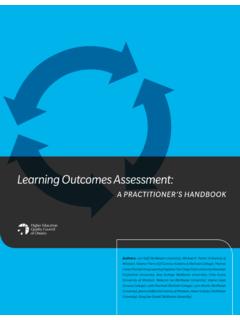Transcription of Apprenticeship Training in Ontario: Literature …
1 Apprenticeship Training in Ontario: Literature Review and Options for Further Research Prepared by Graeme StewartHigher Education Quality Council of Ontario Stewart, G. (2009). Apprenticeship Training in Ontario: Literature Review and Options for Further Research. Toronto: Higher Education Quality Council of Ontario. Disclaimer: The opinions expressed in this research document are those of the authors and do not necessarily represent the views or official polices of the Higher Education Quality Council of Ontario or other agencies or organizations that may have provided support, financial or otherwise, for this project.
2 Published by: The Higher Education Quality Council of Ontario 1 Yonge Street, Suite 2402 Toronto, ON Canada M5E 1E5 Phone: (416) 212-3893 Fax: (416) 212-3899 Web: E-mail: Queens Printer for Ontario, 2009 1 Apprenticeship Training in Ontario: Literature Review and Options for Further Research Introduction At first glance, Apprenticeship Training appears to be a perfect educational solution for many Ontarian, providing a clear pathway into the labour market. Moreover, its heavy emphasis on on-the-job Training makes it a potentially attractive option for individuals who are not inclined toward the classroom and lecture hall-based instruction of university and college.
3 Nevertheless, Apprenticeship Training remains a very small part of Ontario s postsecondary picture. Enrolment in apprentice programs stagnated in the 1990s relative to other forms of higher education (Sharp, 2003), and experienced an actual decline during the recession experienced in the first half of that decade (Skof, 2006). While the absolute number of registrations has once again begun to grow, completion rates have not recovered at the same rate (Skof, 2006).1 More troubling, this same research indicates that nearly half of apprentices in Alberta, New Brunswick, and Ontario fail to complete their Training programs at all (Morissette, 2008).
4 This may indicate a serious retention problem within Canada s Apprenticeship systems. Research also shows Apprenticeship is still largely the domain of older, male workers. The average age of apprentices was 29 in 2003, and despite a variety of programs designed to encourage women to pursue Apprenticeship Training , only per cent of registrants are female (Skof, 2006; Sharpe & Gibson, 2005). Aboriginal individuals, individuals with disabilities, and immigrants are also under-represented in Ontario s Apprenticeship system (Canadian Apprenticeship Forum, 2004).
5 Ontario also appears to be lagging behind its Canadian peers in terms of the proportion of the population with an Apprenticeship or trades certificate or diploma in the skilled trades. Only per cent of Ontarians aged 25-64 indicate a skilled trades certification as their highest level of postsecondary achievement, as compared to a national average of per cent. In Quebec, per cent of 1 This may be a function of the time it takes to complete an Apprenticeship program. Recent Statistics Canada research suggests more than half of apprentices take longer than the nominal length of their Apprenticeship to complete their program.
6 Of completers, 87 per cent finished their program within six years. In Ontario, nine per cent of apprentices are still enrolled in their programs 11 years after their initial enrolment. Thus, the stagnant completion rates relative to the increase in new registrations may be due to a lag generated by long completion times (Morissette, 2008). The results of increased apprentice registration in the late 1990s and early 2000s may only now be reflected in completion numbers. 2 Apprenticeship Training in Ontario: Literature Review and Options for Further Research individuals aged 25-64 posses a skilled trades credential (Statistics Canada, 2008).
7 2 Understanding what works and what doesn t in Ontario s Apprenticeship system cuts across the Higher Education Quality Council of Ontario s (HEQCO) mandate. It has implications for the accessibility of Ontario s postsecondary system, in terms of providing education options that work for all of Ontario s potential learners. It involves questions of system design, inasmuch as it is an educational pathway important both on its own and in the way it interacts with other forms of higher education. Learning quality is also an important issue in Apprenticeship Training , as the strength of instruction in the vocational Training system will have a serious impact on the ability of Ontario s workforce to respond to the challenges of a knowledge economy.
8 Finally, Apprenticeship is also intrinsically linked to accountability, as public funds are an important financial support of the Apprenticeship system. This paper is intended to provide a brief overview of the relevant Literature on Apprenticeship in Ontario, Canada, and around the world. It pays particular attention to the challenges facing Apprenticeship systems in the 21st century. The Literature review will also be used as a starting point for posing a series of research questions aimed at developing a better understanding of how Apprenticeship in Ontario may be improved and expanded.
9 Overview: Apprenticeship in Ontario Expressed in the simplest terms, Apprenticeship refers to a form of vocational Training in the skilled trades that is primarily undertaken on-the-job under the supervision of certified journeypersons. During the Training period, apprentices are paid employees of the organization providing the Training . Alongside workplace instruction, apprentices in Ontario receive a portion of their Training in a classroom environment, usually through a college of applied arts and technology (CAAT). At the completion of an Apprenticeship program, the apprentice writes a series of exams and is certified as a journeyperson in their trade.
10 Apprenticeship is a longstanding educational pathway for Ontarians seeking entry into the workforce. Indeed, Apprenticeship predates most other forms of postsecondary education in the province. The Government of Ontario has been actively involved in Apprenticeship Training since 1928, when it began to actively 2 It should be noted that Quebec does not have a formal Apprenticeship Training system. Skilled Trades Training is accomplished primarily through the c geps, which may explain the relatively higher level of attainment in this area.










